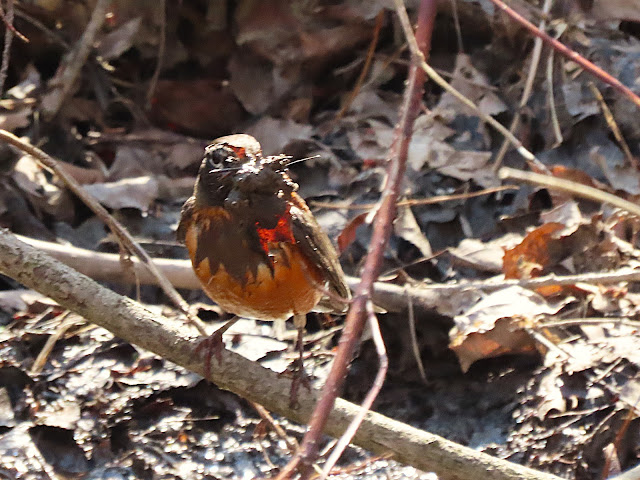23 April, 2025
The Mill Race, St. Jacobs, ON
It's safe to say that an Eastern Chipmunk (Tamias striatus) was not engaged in such idle speculation.
You can be sure, before you have gone very far, a Black-capped Chickadee (Poecile atricapillus) will put in an appearance.
Common Sunburst Lichen (Xanthoria parietina) will provide excellent building material for a hummingbird nest.
The surface of the water was alive with North American Common Water Striders (Aquarius remigis), always a source of fascination for me.
In recent years the trail has developed quite a few holes and people have used their ingenuity to alert fellow walkers to the danger.
I suspect that Baltimore Orioles (Icterus galbula) breed along the Mill Race every year; here is evidence of last year's activity.
The very attractive new growth here is that of a tree in the subfamily Amygdaloideae, part of the family Rosaceae. I am unable to get any more specific than that.
Black Knot (Apiosporina morbosa) is a fungus affecting members of the Prunus genus, such as cherry, plum, apricot and chokecherry trees in North America.
We heard a loud splash near the bank and knew we had startled something, probably a mammal or a large turtle.
Benjamin Park
This location is a mere five minutes walk from our front door, and even though the park is surrounded by suburbia, it hosts a representative sample of Nature's bounty. In the spring, wildflowers especially are abundant and varied.
Magnolias (genus Magnolia) do not retain their blossom for long, but at its peak the blossom is magnificent.
Carolina Spring Beauty (Claytonia carolineana), small, delicate and achingly beautiful, on the other hand, was exuberant.
I look forward to the blooming of every spring ephemeral, but Bloodroot (Sanguinaria canadensis) is one of my favourites.
I think that Miriam outshone herself with many of these pictures, but her macro shot of Lungwort (Pulmonaria officinalis) is exceptionally beautiful to my eyes.
Common Comfrey (Symphytum officinale)
Squills (genus Scilla)
Colt's-Foot (Tussilago forfara) is both early and prolific and forms a series of bright yellow buttons spread across the landscape.
Butterflies have been scarce this year. Small White (Pieris rapae) is the only one we have seen with any degree of regularity.
Health Valley Trail, Waterloo
The Health Valley Trail goes from Waterloo to St. Jacobs for a distance of about 5km. We parked at the Waterloo end, walked about half way and reversed direction.
The trail starts off by skirting a farmer's field.
In early spring when the ice broke up the Conestogo River overflowed its banks and much debris was left behind.
Midland Painted Turtles (Chrysemis picta marginata) hauled out to bask in the warmth of spring sunshine.
It seems quite late for a Greater Yellowlegs (Tringa melanoleuca) to be migrating north and to early for it to be already heading south, so perhaps this individual decided to forego breeding this year and remained here.
Yellow Trout Lily predominated, but White Fawn Lily (Erythronium albidum) was spotted here and there.
Virginia Spring Beauty (Claytonia virginica) is distinguished from Carolina Spring Beauty by stalkless linear leaves more than 7cm long.
Yellow Trout Lily
The presence of a Solitary Sandpiper (Tringa solitaria) added an exclamation point to our riverside stroll.
It's always interesting to see the growth that occurs in an old rotting stump - the fulfillment of Nature's recycling.
The river was full of small fish - North American Minnows in the subfamily Pogonichthyinae, but specific identification was difficult - and for me, impossible!
Wide Leek (Allium tricoccum) is a common plant, but I have never tried it in our cuisine. Perhaps I should.
These three walks were all quite short, no more than a couple of hours each, but they enable you to see the rich diversity of Southern Ontario.
It's a great place to live!























































































Oooh. And ahhh.
ReplyDeleteWalking with the two of you never disappoints. Thank you.
And I do love your smiling owl header too.
David, your eye for detail and deep appreciation for nature really shines through here. Those little moments—the chipmunks, the birds, even the fungi—remind me how much beauty is just waiting to be noticed on a simple walk. Thanks for sharing this peaceful glimpse into spring.
ReplyDeleteWonderful photos David. Nature in full swing. Great to see :-D
ReplyDeleteThank you for taking us along...those wild flowers are really pretty. That cardinal is gorgeous.
ReplyDeleteHi David.
ReplyDeleteThis walk is great.
Beautiful nature.
Many beautiful flowers.
Beautiful birds, beautiful the woodpecker and the cardinal.
The squirrel is nice.
Greetings from Patricia.
Thank you so much for the beautiful pictures of all the wildflowers, David. Yes, the Bloodroot, Erythronium, and the picture of Pulmonaria are all so beautiful and they brighten up where I sit. You also show many beautiful birds today.
ReplyDeleteHugs and kisses, Marit
Enjoyed every bit of that! Most of my childhood was spent in Muskoka, where all those spring ephemerals, grow in abundance. They are old friends.
ReplyDeleteYou really must try leeks! Fresh caught brookies and freshly dug leeks.... Heaven!
I have a wild imagination and I do see things when I am out there, just like that face in the tree. With all the spring birds and buds, I kept thinking I was seeing birds on the tree tops until I zoomed in and saw they were not birds but more buds. I wonder what camera you use? Mine is a Canon Powershot SX 70 HS.
ReplyDeleteWe use the same camera. We find them perfect for our use and not at all cumbersome to tote around.
Delete...David, thanks for taking me along on these walks. Blood root is indeed an ephemeral, this year it bloomed while I was asleep!
ReplyDeleteHari Om
ReplyDeleteThe spring flowers as absolutel jewels... I swear I could smell the violets! YAM xx
I love all of those ephemeral flowers, our are done now and the forest trees are in full leaf and ready for the next event. The Trout Lilys are probably my favorite flower to see. Well, okay...all of them.
ReplyDeleteI've missed going out on long walks this spring but at least I'm enjoying it here.
Gorgeous spring flowers and the birds are fascinating too, as always. Sometimes I wonder why you seem to have so many more species of both birds and spectacular wildflowers than we have here (in Eastern Finland). :) How is your climate zone called? Ours is Southern boreal.
ReplyDeleteWe had finally some rain and now everything is wonderfully green.
Happy spring days!
I live in the southern part of the province where the ecosystem is known as the St.Lawrence Lowlands, characterized by primarily deciduous woodland. The Boreal Forest to the north would resemble Finland more closely.
DeleteYour profile page links to your blog, and also to Sara’s Villa Emilia. I’ve been confused by this!
DeleteYour photos of birds and plants are especially wonderful today. You see so many different types of flowers in your woodlands.
best… mae at maefood.blogspot.com
I had no idea that this happens, Mae. I will see if I can fix it.
DeleteBeautiful spring flowers! And the birds are nice too. I used to see faces in the canyon walls when I was wilderness canoe camping.
ReplyDeleteBeautiful birds. And as a bonus, really beautiful flowers. White magnolia is one of my favorites.
ReplyDeleteKiitos David taas upeista kävelyretkistänne, joilla sain olla mukana. Teillähän on ihan fantastinen kotipaikka - lähellä noin valtava määrä kauniita asioita. Toisaalta sinulla ja Miriamilla on sellaiset silmät, jotka näkevät enemmän kuin jonkun toisen silmät...
ReplyDeleteWhat a glorious walk, David! So many beautiful nature photos here, the flowers, the turtles, the birds, the chipmunk. Thank you so much for sharing this series of photos, you have made my day!
ReplyDeleteThose three short walks yielded some glorious photos. Imagine if you had more time!
ReplyDeleteThe birds and flowers are absolutely beautiful, David.
ReplyDeleteI enjoyed your great post about that not spoiled corner of the world. The photos of the green frog and the White-breasted Nuthatch are superb. Lovely picture of the turtles.
ReplyDeleteBeautiful report!
I enjoyed these walks very much. I have never seen the white lily, or a Yellowleg either. Something new!
ReplyDeleteI loved seeing all the spring wild flowers. I somehow missed seeing the blooms here - just managed to see the greenery when we cleaned up trash on our road in April.
ReplyDeleteAnd you were right about US not being the only nation to stop the aggression in WWII.
All three walks show so much beauty and the abundance of nature. The American Robin might be a common bird, but it sure is a dear one. Whenever I work in the front garden, there is an American Robin sitting on the wire, singing. I tell myself that he comes there just to entertain me. Weeding suddenly is not as burdensome.
ReplyDeleteI agree, the image of the lungwort is excellent! Miriam really is a very artful photographer. Of course I enjoy the pictures of the lichens and the growth out of a tree stump - fascinating. These are things that never cease to amaze me. That's why short walks usually take hours (and you really have to be in the right company - that's probably why I do most of them on my own). David, thank you for taking us along, it was very enjoyable! Hugs - Carola
Que tal, good foggy evening, dear David!
ReplyDeletehow wonderful that this place is just five minutes from your home. You don't have to go far to experience nature's extraordinary gift. I love this delightful walk, so full of life.
Sending gros bisous
to you.
Thanks for taking us along on your walks and thanks to Miriam for those fabulous pictures - especially the Greater Yellowlegs and Solitary Sandpiper. Wonderful birds!
ReplyDeleteExquisite pictures, David. If I had to pick a favorite, I'd lean towards that endearingly beautiful White-breasted Nuthatch. Aw.
ReplyDeleteMuch gratitude.
I am not familiar with chickadees. Are they the same or similar as woodpeckers, which we find here? They too make nests on bark of the trees.
ReplyDeleteWoodpeckers are in a different family, Pradeep (Picidae). Birds in India that would be in the same family as chickadees (Paridae) would be White-naped, Tit, Rufous-named Tit, Sultan Tit etc. Thanks for stopping by my blog.
DeleteThat should say, White-naped Tit, Rufous-naped Tit……
DeleteThank you, David, for the explanation.
DeleteThanks for taking us along. Beautiful birds and of course we know my favourite.
ReplyDeleteThe daffodils do look lovely there, and I expect the were planted by someone.
The plants are pretty, the creature are good to see.
What a beautiful series of photos David.
ReplyDeleteI think the eastern chipmunk is really beautiful, we don't see it here.
The white-breasted nuthatches are also beautiful, in our country it has an orange breast, the Northern Cardinal is also beautiful, it doesn't occur in our country either.
Muskrats are a plague here in the Netherlands, they dig tunnels in the dikes with all the consequences, so here the muskrat is hunted, the Netherlands is far below sea level, so if the dikes break it is a huge disaster for our country.
The other photos are also very beautiful.
Greetings Irma
I can see that Muskrats would be a problem!
DeleteSpring showing is beauty trough your eyes...
ReplyDeleteAnna
this planet is so full of awe inspiring critters, birds and flowers and you have managed to get amazing shots of something for all of us.. even the black rot is beautiful. the flowers look like I could reach in and pick one for my kitchen. love the but shot of the bird, made me laugh... make that tail feather shot.. I would love to see what you see with your lens, thanks for the walk in nature..
ReplyDeleteIf ever you were in southern Ontario it would be my pleasure to take you for a walk, Sandra. I would announce to all the chickadees and nuthatches in the neighbourhood that they should alight on your hand in greeting.
DeleteIt does look like a beautiful area to live in, David. I agree with you about Miriam's photo of the lungwort--it's spectacular! The chickadees always bring back memories of sitting by the window in our house in Fairbanks watching them come to the feeder for some breakfast on late mornings in winter as it slowly got a little bit lighter outside. In Maine, we had some kind of tree outside our bedroom window which had berries on it. There was a cardinal who spent a great deal of time there and in summer felt that 4 am was the best time to either sing his little heart out or to yell at (presumably) another bird who got a little too close for his liking. I never knew whether I was going to wake up to a song or a 'shouting' match :-)
ReplyDeleteAnd I thought that Bill serenaded you each morning!
DeleteThat water strider photo was especially interesting. You had some wonderful sightings of late. This is a wonderful series. (That nuthatch is a sweetheart!)
ReplyDeleteThe exception of the red winged black bird, your first two posts look like Home. Lovely pictures and descriptions.. If I had to name a favorite it would be the chickadees. I have three bird houses. They all have wrens nests in them... The first ones to hatch have been lost to a Bluejay.. I'm hoping that the other two nests survive.
ReplyDeleteThanks for taking me along on all your nature walks... I would love to do it in person but I must settle for viewing nature from my couch.. Miriams pictures are wonderful.
A delightful look at all your surrounding nature and its many wonders. My soul feels soothed just be looking at yours. Thank you David!
ReplyDeleteHello David,
ReplyDeleteYou don't need to exaggerate the natural beauty of your country any more. Anyone who follows your mail knows how beautiful it is there. The lilies are my favorite.
Greetings, Frank
You did some serious tramping around. I love seeing a family of turtles basking on a log. Were the holes in the tree that the chickadees were getting ready to occupy made by man or woodpeckers or something all together different?
ReplyDeleteAlmost certainly the holes were made by woodpeckers.
DeleteYou always provide a great walk. I like the Dutchman's breeches. Not familiar with that flower.
ReplyDeleteYou've had some lovely walks. I didn't know trout lilies bloomed that early, but they are very lovely. And that willow blooms are absolutely cool. I don't think I've ever seen these up so close. And you managed to snap some more fabulous photos too! Hope your recent walks have been as lovely. hugs-Erika
ReplyDeleteSo many gorgeous photos. I love the frog. The Pieris rapae is a gardeners foe. They lay eggs on brassicas especially cabbage and then the worms can devastate a plant. But you probably already know that. LOL
ReplyDeleteTo me, the old tree looks like another tree got mad at it and rearranged its face:)
ReplyDeleteHi David, 3 times a nice walk. Gorgeous flowers en beautiful birds. Love the wings of the Box elder. The Sitta canadensis is one of my favorites. And WOW the Greater Yellowlegs and the solitary Sandpiper, The Lone tree...to much to mention all. But Miriam did a good job with al the beautiful macro's of the flowers.
ReplyDeleteRegards Maria
I think this is one of the most complete posts you have ever written.....lots of beautiful pictures showing a great biodiversity!!.........Abrazotes, Marcela
ReplyDeleteMarvelous pictures. Thanks for sharing your walks and for seeing the small things.
ReplyDeleteWonderful walks and a great selection of photographs.
ReplyDeleteYes, I can see faces in the old tree.
All the best Jan
Me ha parecido maravilloso querido amigo David, yo sería feliz paseando por ahí con tan bella naturaleza. Abrazos y feliz mes de junio.
ReplyDelete